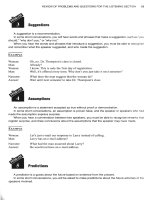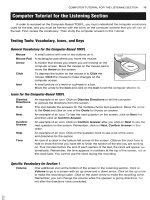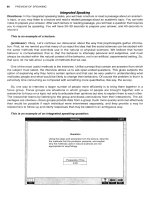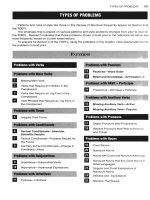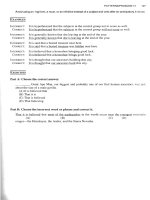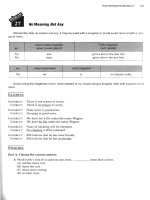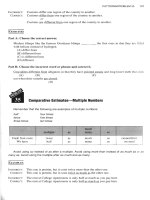Tài liệu How to prepare for the toefl part 59 pdf
Bạn đang xem bản rút gọn của tài liệu. Xem và tải ngay bản đầy đủ của tài liệu tại đây (535.93 KB, 10 trang )
/
MODEL TEST 5 COMPUTER-ASSISTED TOEFL
583
Answer
(A)
Because
either
means that the speaker is including herself in her statement, it must be conclud-
ed that the woman did not go to the meeting. The man said that he did not go because of a headache.
Choice
(B)
is not correct because of the use of the word
either
in the woman's question. Choice
(C)
is not correct because of the man's negative response to the question of whether he went to the
meeting. Choice
(D)
is not correct because of both the use of the word
either
and the man's negative
response.
Audio
8.
Woman:
I
have a card, but now
I
need a farewell gift for my advisor.
Man:
How about a nice pen?
Narrator:
What does the man mean?
Answer
(B)
"How about [buying] a nice pen?'Choice (C) refers to the card that the woman has already pur-
chased, not to the man's idea. Choice
(D)
is not correct because the man offers a suggestion for
a
gift. Choice
(A)
is not mentioned and may not be concluded from information in the conversation.
Audio
9.
Man: Are you going to move out of the dorm next semester?
Woman:
I
just can't seem to make up my mind.
Narrator: What does the woman mean?
Answer
(D)
To
not make
up
one's
mind
is an idiomatic expression that means to "be undecided." Choices
(A)
and (C) are not correct because she is still considering both alternatives. Choice (B)
is
not cor-
rect because she has a choice.
Audio
10.
Man:
I
signed the contract.
Woman: Do you really think you can work and go to school full time?
Narrator: What does the woman imply?
Answer
(A)
Since the woman asks whether the man can work and go to school, she implies that he may be
taking on too much. Choices (B),
(C),
and
(D)
are not mentioned and may not be concluded from in-
formation in the conversation.
Audio
11.
Woman:
I
owe everyone in my family a letter, but
I
really don't have time to sit down and
write them and it's too expensive to call.
Man: Why don't you just buy some postcards?
Narrator:
What does the man suggest the woman do?
Answer
(C>
Since the man suggests that the woman buy postcards, it must be concluded that she should send
postcards to her family. Choice (B) is not correct because she does not have time to write a letter.
Choice
(A)
refers to the man's family, not to the woman's family. Choice
(D)
is not mentioned and
may not be concluded from information in the conversation.
584
EXPLANATORY ANSWERS
AND
AUDIO SCRIPTS
Audio
Man:
Are you going to stay here for graduate school?
Woman:
I
don't think so.
Man: Have you heard from any schools yet?
Woman: Yes,
I
was accepted at Kansas State, the University of Oklahoma, and the University
of Nebraska, but I'm going to wait until
I
hear one way or another from the
University of Minnesota.
Narrator:
What are the speakers discussing?
1
Answer
(B)
Choices (A), (C), and
(D)
are all mentioned as they relate to the main topic of the conversation,
"where the woman will go to school."
Audio
13.
Woman:
I
thought
I
was supposed to take the test in Room
32.
Man:
No. Ticket number 32 is in Room
27.
Narrator: What will the woman probably do?
Answer
(B)
Since the man says that ticket number 32 is in room 27, the woman will probably go to room
27.
Choice
(A)
is not correct because the woman already has a ticket. Choice
(C)
refers to the number
of the ticket, not to the number of the room. Choice (D) is not correct because the man has already
seen her ticket.
Audio
14.
Man: Where did you get the flower?
Woman: At the Honors Reception. The teachers gave them to all of the honors students.
Narrator: What can be inferred about the woman?
Answer
(B)
Since the teachers gave flowers to all of the honors students and the woman has a flower, it must
be concluded that she is an honors student. Choice
(A)
is not correct because she has
a
flower that
was presented at the reception. Choice (D) is not correct because she received a flower for students.
Choice (C) is not mentioned and may not be concluded from information in the conversation.
Audio
15.
Man:
Terry is really having trouble in Dr. Wise's class. She's missed too much to catch up.
Woman: If
I
were Terry, I'd drop the course, and take it over next semester.
Narrator: What does the woman suggest that Terry do?
Answer
(D)
". . .
take it over next semester." Choices
(B)
and
(C)
are not correct because the woman says to
drop the class. Choice (A) is not mentioned and may not be concluded from information in the
conversation.
Audio
16.
Woman:
I
used to teach English before
I
came back to graduate school.
Man: No wonder you like this course!
Narrator: What does the man mean?
MODEL
TEST 5 COMPUTER-ASSISTED TOEFL
585
Answer
(C)
Since the woman used to teach English, the man is not surprised that she likes the course.
No
wonder
is an idiomatic expression that means the information is logical. Choice (D) refers to the
woman's interest, not to the course. Choices
(A)
and (B) are not mentioned and may not be con-
cluded from information in the conversation.
Audio
17. Man: We should ask Carl to be in our group.
Woman: We probably ought to ask Jane, too. She's really good at making presentations.
Narrator:
What problem do the students have?
Answer
(A)
Since they are discussing potential group members and their value to a presentation, it must be
concluded that they are planning to make a presentation. Choice
(B)
is not correct because the
woman says they should ask Jane. Choices (C) and (D) are not mentioned and may not be conclud-
ed from information in the conversation.
QUESTION DIRECTIONS-Part
B
In Part B of the Listening Section, you will hear several longer conversations and talks. Each con-
versation or talk is followed by several questions. The conversations, talks, and questions will not be
repeated.
The conversations and talks are about a variety of topics. You do not need special knowledge of the top-
ics to answer the questions correctly. Rather, you should answer each question on the basis of what is
stated or implied by the speakers in the conversations or talks.
For most of the questions, you will need to click on the best of four possible answers. Some questions
will have special directions. The special directions will appear in a box on the computer screen.
Audio
Conversation
Narrator: Listen to part of a conversation between two students on campus.
Man: To tell the truth,
I
really don't know what Dr. Brown wants us
to
do. The assignment
was pretty vague.
Woman:
I
know. I've already looked in the syllabus, but all it says under the course require-
ments is "Research paper, thirty points."
Man:
Thirty points? I hadn't realized that it counted so much. That's almost one-third of
the grade for the course.
Woman:
That's why I'm so worried about it. At first I thought she wanted us to do library re-
search, and write it up; then she started talking about presentations. Last week she
said there would be time during the next to the last class for us to present.
Man:
I
was thinking about making an appointment to see her, or just stopping by during
her ofice hours.
Woman: You could do that. But since so many of us are confused, maybe we should ask about
it in class tomorrow. I bet we won't be the only ones with questions either.
Man: That's a good idea.
Now get ready to answer the questions
586
EXPLANATORY ANSWERS
AND
AUDIO SCRIPTS
Audio
18.
What problem do the speakers have?
Answer
(B)
"I
really don't know what Dr. Brown wants us to do.
. . .
The assignment was pretty vague."
Choice (A) is not correct because they looked in the syllabus. Choice (C) refers to the fact that the
man was thinking of making an appointment with Dr. Brown to resolve the problem. Choice
(D)
is
not correct because the man was considering stopping by Dr. Brown's office during her office hours.
Audio
19.
How much does the research paper count toward the grade for the course?
Answer
(D)
". . .
it says under the course requirements.
.
.
.
"
Research paper, thirty points."' Choice (A) is
not correct because it says thirty points in the syllabus. Choice
(B)
is not correct because thirty
points is one-third, not one-half, of the total grade. Choice (C) is not correct because it is thirty, not
ten, points.
Audio
20.
What did the professor say last week?
Answer
(A)
".
. .
then she started talking about presentations." Choice (C) refers to the fact that the students
are planning to ask questions in the next class, not to questions that were asked last week. Choices
(B)
and (D) are not mentioned and may not be concluded from information in the conversation.
Audio
21.
What will the students probably do?
Answer
(C)
".
.
.
maybe we should ask about it in class tomorrow." Since the man agrees that she has a good
idea, it must be concluded that they will ask questions about the assignment in class. Choices
(B)
and (D) were discussed earlier in the conversation before they decided to ask in class. Choice (A) is
not correct because they do not understand the assignment.
Audio Lecture
Narrator: Listen to part of a lecture in a world history class. Today the professor will talk about
exploration and discovery. She will focus on the Hawaiian Islands.
On his third exploratory voyage, as captain of two ships, the
Resolution
and the
Discovery,
Captain James Cook came upon a group of uncharted islands that he named the Sandwich
Islands as a tribute to his friend, the Earl of Sandwich. Today the islands are known as the
Hawaiian Islands.
Some historians contend that the islanders welcomed Cook, believing that he was the god
Launo, protector of peace and agriculture.
I
have that name written on the board for you.
Of
course, it didn't take long for them to realize that Launo had not returned.
These islanders were short, strong people, with a well-organized social system. The men
fished and raised crops, including taro, coconuts, sweet potatoes, and sugarcane. The women
cared for the children and made clothing-loin cloths for the men and short skirts for the
women. The natives were eager to exchange food and supplies for iron nails and tools, and
Cook was easily able to restock his ship.
MODEL TEST 5 COMPUTER-ASSISTED
TOEFL
587
Because of a severe storm in which the
Resolution
was damaged, it was necessary to return
to Hawaii. Now sure that Cook and his crew were men and not gods, the natives welcomed
them less hospitably. Besides, diseases brought by the English had reached epidemic propor-
tions. When a small boat was stolen from the
Discovery,
Cook demanded that the king be taken
as a hostage until the boat was returned. In the fighting that followed, Cook and four crewmen
were killed.
I
Now get ready to answer the questions
1
Audio
22.
What is the main subject of this lecture?
Answer
(C)
"On his third exploratory voyage, as captain of two ships.
.
. .
Captain James Cook came
upon
.
.
.
the Hawaiian Islands." Choices
(A),
(B),
and
(D)
are secondary themes used to develop the
main theme of the talk.
Audio
23.
According to the lecturer, what were the two ships commanded by Captain Cook?
Answer
(B)
(C)
".
. .
as captain in charge of two ships, the
Resolution
and the
Discovery,
Captain James
Cook came upon a group of uncharted islands.
.
.
."
Choice
(A)
refers to the fact that this was Cook's
third voyage to explore the Pacific Ocean, not to the name of his ship.
England
in Choice
(D)
refers
to the country that commissioned Cook, not to the name of his ship.
Audio
24.
Why does the professor mention the name
Launo?
Answer
(C)
"Some historians contend that the islanders welcomed Cook, believing that he was the god
Launo, protector of peace and agriculture." Choices
(A),
(B),
and
(D)
are not mentioned and may
not be concluded from information in the lecture.
Audio
25.
The professor briefly explains a sequence of events in the history of Hawaii. Summarize the
sequence by putting the events in order.
Answer
(D)
(C)
(B)
(A)
".
. .
Cook demanded that the king be taken as a hostage until the boat was returned.
In the fighting that followed, Cook and four other crewmen were killed."
Audio Lecture
Narrator:
Listen to part of a lecture in an engineering class. The professor will discuss alloys.
An alloy is a substance that is formed by combining a metal with other metals, or nonmetals.
For example, brass is an alloy of the metals copper and zinc, and steel is an alloy of the metal
iron with the nonmetal carbon.
The special characteristics of metals, such as hardness, strength, flexibility, and weight are
called its properties. By the process of alloying, it is possible to create materials with the exact
588
EXPLANATORY ANSWERS AND ALlDlO SCRIPTS
combinations of properties for a particular use. In the aircraft industry, there is a need for met-
als that are both strong and light. Steel is strong but too heavy, whereas aluminum is light but
not strong. By alloying aluminum with copper and other metals, a material that is strong enough
to withstand the stresses of flight, but light enough to reduce the cost of fuel to lift the craft is
created. By alloying steel with nickel and chromium, the steel alloy that results is not only
lighter but also stronger than solid steel.
Of course, there is
an
important difference between the alloys we have used in our examples
and the combination of metals that occur accidentally as impure metals. Both are mixtures,
but ailoys are mixtures that have been deliberately combined in specific proportion for a definite
purpose.
Now get ready to answer the questions
Audw
26.
What is an alloy?
Answer
(C)
".
. .
alloys are mixtures that have been deliberately combined in specific proportion for a defi-
nite purpose." Choice
(A)
refers to natural combinations of metals, not to alloys. Choice (B) is true
but incomplete because it does not mention the specific purposes. Choice
(D)
is not mentioned and
may not be concluded from information in the conversation.
Audio
27.
What does the speaker say about the properties of alloys?
Answer
(A)
(B)
".
. .
alloys are mixtures that have been deliberately combined in specific proportion for
a
definite purpose." Choice
(D)
refers to impure metals, not to alloys. Choice (C) is not mentioned
and may not be concluded from information in the conversation.
Audio
28.
Why does the speaker use the example of the aircraft industry?
Answer
(A)
"In the aircraft industry, there is a need for metals that are both strong and light." Choice
(D)
is
not correct because the metals referred to are alloys. Choices (B) and (C) are not mentioned and
may not be concluded from information in the conversation.
Audw
29.
What is the difference between combinations of metals in nature and alloys?
Answer
(C) "Both [alloys and combinations in nature] are mixtures, but alloys are mixtures that have been
deliberately combined in specific proportion for a definite purpose." Choice
(A)
is not correct be-
cause metals that occur accidentally in nature are impure. Choice (B) is not correct because combi-
nations of metals occur accidentally in nature. Choice
(D)
is not correct because both alloys and
combinations of metals that occur in nature are mixtures.
MODEL
TEST
SCOMPUTER-ASSISTED
TOEFL
589
Audio Discussion
\
i
Narrator: Listen to part of a discussion in an English class.
John:
Mary:
Baker:
Mary:
Baker:
John:
Baker:
Mary:
Baker:
Mary:
John:
Mary:
John:
Mary:
Baker:
Mary
:
John:
Baker:
John:
Mary:
British English and American English are really about the same, aren't they?
I don't think so. It seems to me that some of the spellings are different.
You're right, Mary. Words like
theater
and
center
end in
re
in England instead of in
er,
the way that we spell them. Let me write that on the board. Can you think of any
more examples?
The word
color?
Good. In fact, many words that end in
or
in American English are spelled
our
in
British English, like
color
and
honor:
I'm still not convinced.
I
mean, if someone comes here from England, we can all un-
derstand what he's saying. The spelling doesn't really matter that much.
Okay.
Are
we just talking about spelling? Or are there some differences in pronunci-
ation and meaning too?
Professor Baker?
Yes?
I
remember seeing an English movie where the actors kept calling their apartment a
flat.
Half of the movie was over before
I
realized what they were talking about.
So there are slight differences in spelling and some vocabulary.
And pronunciation, too. You aren't going to tell me that you sound like Richard
Burton.
Richard Burton wasn't English. He was Welsh.
Okay. Anyway, the pronunciation is different.
I think that what we are really disagreeing about is the extent of the difference. We
all agree that British English and American English are different. Right?
Yes.
Sure.
But not so different that it prevents us from understanding each other.
Well, that's what
I
mean.
That's what
I
mean, too.
Now get ready to answer the questions
Audio
30.
What do the speakers mainly discuss?
Answer
(C)
"We all agree that British English and American English are different. Right?
.
.
.But not so
dif-
ferent that it prevents us from understanding each other." Choices (A), (B), and
(D)
are secondary
points of discussion that are used to develop the main topic of the discussion.
Audio
31.
How are these words referred to in the discussion?
Answer
(A)
(B)
(C)
(D)
"Words like
theater
and
center
end in
re
in England instead of
er;
the way that we
[Americans] spell them.
. . .
In fact, many words that end in
or
in American English are spelled
our
in British English, like
color
and
honor."
590
EXPLANATORY ANSWERS
AND
AUDIO SCRIPTS
Audio
32.
What can be inferred about the wordflat in British English?
Answer
(B)
"I
remember seeing an English movie where the actors kept calling their apartment aJZat. Half
of the movie was over before
I
realized what they were talking about." Choice
(D)
is not correct be-
cause the woman did not understand the word. Choices
(A)
and (C) are not mentioned and may not
be concluded from information in the discussion.
Audio
33.
On what did the class agree?
I
Answer
(D)
"We all agree that British English and American English are different.
.
. .
But not so different
that it prevents us from understanding each other." Choice
(A)
refers to the man's opinion at the be-
ginning of the discussion, not to the opinion of the class at the conclusion of the discussion. The
opinions expressed in Choices
(B)
and
(C)
are not mentioned and may not be concluded from infor-
mation in the discussion.
Audio
Talk
Narrator: Listen to
part
of a talk in an education class. A student is giving
a
presentation about
local control of schools.
My report is on local control of schools. First,
I
was surprised to learn that public schools in
the United States are not the same in every state or even from community to community within
the state. The reason for differences in organization, curriculum, and school policies is because
each school district has a governing board, called the school board, that makes the decisions
about the way the schools in their district will be run. Of course, a superintendent is selected by
the board to carry out policies and the superintendent is usually a professional educator, but the
board, often made up of community leaders who are not professional educators, must approve
the recommendations of the superintendent.
There are two ways to organize a school board. In most communities, the board is elected by
the residents in their local school district. And the members usually serve without pay for three
to five years. But in some districts, the school board is appointed by the mayor.
Of course, the federal government has an interest in improving education on a national level,
even though schools are controlled locally. But the function of the national department is very
different from a department of education in many parts of the world. This national agency
is
pri-
marily involved in collecting demographics, supporting research and projects, and supervising
the compliance of schools with national legislation.
1
Now get ready to answer the questions
I
Audio
34.
What is the presentation mainly about?
Answer
(D)
"My report is on local control of schools." Choices (A), (B), and
(C)
are secondary themes used
to develop the main theme of the report.
MODEL TEST 5 COMPUTER-ASSISTED TOEFL
591
Audw
35.
What surprised the presenter about her research?
Answer
(A)
".
. .
I was surprised to learn that public schools in the United States are not the same
in
every
state or even from community to community.
. . .
"
Choices
(B),
(C),
and
(D)
are all true, but they
are not what surprised the presenter about her research.
Audw
36.
How does each of the persons identified contribute to the operation of schools in the United States?
Answer
(B)
(A)
(C)
".
.
.
a governing board, called the school board, that makes the decisions
.
. .
a superin-
tendent .to carry out policies.
.
. .
In most communities, the board is elected by the residents in their
local school district."
Audio
37.
According to the speaker, what is the function of the department of education in the United States?
Answer
(A)
(C)
"The function of the national department is
.
.
.
supporting research and projects, and super-
vising the compliance of schools with national legislation." Choice
(B)
is not correct because the
school board makes decisions about the cumculum in the local district. Choice
(D)
is not correct be-
cause local school boards are elected by the people or appointed by the mayor.
Audio Conversation
Narrator: Listen to part of a conversation between a student and a secretary in a college
dormitory.
Man:
Woman:
Man:
Woman:
Man:
Woman:
Man:
Woman:
Man:
Woman:
Man:
Woman:
Man:
Woman:
Man:
Woman:
I
want to buy a meal ticket.
Okay. Which plan do you want?
You mean there is more than one?
Sure. You can buy one meal a day, two meals a day, or three meals a day.
Oh. If I buy two meals a day, can
I
choose which meals?
Not really. The two-meal plan includes lunch and dinner. No breakfast.
Great. That's what I would have wanted anyway. How much is that?
It's thirty-six dollars a week, which works out to about three dollars a meal.
Wait
a
minute. Fourteen meals at three dollars would be forty-two dollars,
wouldn't it?
Yes, but we don't serve meals on Sunday.
Oh.
Most residents order a pizza or go out to eat on Sundays. Of course, some students
live close enough to go home for the day.
Okay. I'll take the two-meal plan. Do
I
pay by the quarter or by the week?
By the quarter.
Fine. Do you take credit cards?
Yes, but you don't have to pay now. Just fill out this form, and we'll bill you.
I
Now get ready to answer the questions
I
592
EXPLANATORY ANSWERS AND ALlDlO SCRIPTS
Audio
38.
What kind of meal plan does the man decide to buy?
Answer
(B)
(C)
"The two-meal plan includes lunch and dinner." Choice
(A)
is not correct because there is
no breakfast included. Choice
(D)
is not mentioned and may not be concluded from information in
the conversation.
Audw
39.
How much does the plan cost?
Answer
(C)
"It's thirty-six dollars a week, which works out to about three dollars a meal." The number in
Choice
(A)
refers to the number of meals thatbe man uses to calculate, not the cost. Choice
(D)
refers to the cost of two meals per day for seven days, not to the cost of a six-day plan. Choice
(B)
is not mentioned and may not be concluded from information in the conversation.
Audio
40.
Why do most residents order a pizza or go out to eat on Sundays?
Answer
(C)
". .
.
we don't serve meals on Sunday." Choice
(A)
refers to the situation that some students
have, but not to the reason that they eat out. Choices
(B)
and
(D)
are not mentioned and may not be
concluded from information in the conversation.
Audio
41. How will the man pay for the meals?
Answer
(C)
"Just fill out this form, and we'll bill you." Choice
(B)
refers to the man's question about credit
.cards, not to the way that he will pay. Choices
(A)
and
(D)
are not correct because the man will be
billed.
Audw
42.
What will the man probably do?
Answer
(C)
"Just fill out this form, and we'll bill you." Choice
(A)
is not correct because the man does not
have to pay now. Choice
(B)
refers to the man's offer, not to what he will probably do. Choice
(D)
is not mentioned and may not be concluded from information in the conversation.
Audw Lecture
Narrator: Listen to part of a lecture in a botany class. The professor is talking about
hydroponics.
As you will recall, hydroponics is the science of growing plants without soil, using a solution
of nutrients in water.
Of
course, good soil has the nutrients necessary for plant growth, but when
plants are grown without soil, all the nutrients must be provided in another way. This solution
contains potassium nitrate, ammonium sulfate, magnesium sulfate, monocalcium phosphate,
and calcium sulfate. Don't try to write down all of that now. You can refer to your lab workbook
for the list of substances and the proportions needed for proper plant growth.
